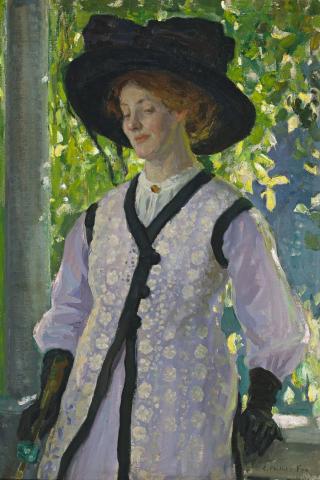ON THE BALCONY, c.1912
EMANUEL PHILLIPS FOX
oil on canvas
96.5 x 64.5 cm
signed lower right: E. Phillips Fox
Gift of the artist to Edith Boyd, Paris, c1912
Thence by descent
Robin Boyd, Melbourne, 1961
Thence by descent
Patricia Boyd, Melbourne, 1971
Estate of the late Patricia Davies (formerly Mrs Robin Boyd), Melbourne
Société Internationale de Peinture et de Sculpture, Galerie Georges Petit, Paris, December 1912, cat. 46 (as 'Sur le balcon')
E. Phillips Fox, 1865–1915, National Gallery of Victoria, Melbourne, 9 November 1994 to 30 January 1995, cat. 54 (label attached verso)
Art, Love and Life: Ethel Carrick and E. Phillips Fox, Queensland Art Gallery, Brisbane, 16 April – 7 August 2011
Zubans, R., E. Phillips Fox 1865–1915, National Gallery of Victoria, Melbourne, 1994, cat. 54, p. 68 (illus.)
Zubans, R., E. Phillips Fox, His Life and Art, Miegunyah Press, Melbourne, 1995, cat. 405, p. 150, pl. C66 (illus.)
Eagle, M., The Oil Paintings of E. Phillips Fox in the National Gallery of Australia, National Gallery of Australia, Canberra, 1997, p. 64
Goddard, A., Art, Love and Life: Ethel Carrick and E. Phillips Fox, Queensland Art Gallery, Brisbane, 2011, pp. 23, 157 (illus. p. 96)
On the Balcony is a very special work of art. Painted when Emanuel Phillips Fox was living in Paris during the height of la belle époque, it presents a captivating essay on elegance and savoir-faire, revealing the poise and grace of an age when Paris was the unrivalled centre of European taste and sophistication. It likewise has considerable historical significance, being the outcome of a fortuitous combination of events. Following his marriage to Ethel Carrick in 1905, the Foxes moved to Paris, the happy coincidence inspiring some of his best paintings. The garden they created for their apartment on the Boulevard Argo was a perfect setting for many, as seen in On the Balcony and its companion Nasturtiums c1912, acquired last year by the Art Gallery of New South Wales in memory of Margaret Olley. These two, together with The Green Parasol in the collection of the National Gallery of Australia, Canberra, are among his most beautiful works. The radiance of each painting matches that of the model, the exquisitely beautiful redheaded Edith Susan Gerard Anderson (1878 -1961). The talented Anderson studied for a time under Fox, her circle of friends including Rupert Bunny and his enchanting French wife Jeanne-Heloise. As the bond between Edith and the Foxes grew, she became his favourite model. Fox introduced her to the artist in the studio next door, Penleigh Boyd. After a whirlwind romance, Boyd and Anderson were married in Paris in October 1912. Fox hosted parties for them and gave Edith away, the wedding present being a portrait of Edith (private collection). On the Balcony was painted during the preceding summer months, as suggested by two entries in Edith's diary for 21and 22 June referring to her posing for Fox 'against sunlit creepers'.1
The significance of On the Balcony in the wider context of Australian art is increased greatly through these associations, painted when Edith was about to enter the Boyd dynasty of highly creative Australians. Her future son, Robin, was one of Australia's most renowned architects. The painter, Arthur, was her nephew. While portraiture was immensely popular during the late nineteenth and early twentieth centuries, aesthetic appeal was held to be of equal importance to likeness. The London Academy and Paris Salon catalogues often listed the sitter's name as an adjunct to the subject title.2 In On the Balcony, the line between portraiture and subject painting is suitably blurred, enhanced by its considerable aesthetic appeal. Who can resist the nuanced smile, inviting modesty of hooded eyes and downward look, demurely avoiding the viewer's gaze? Attired in a pale mauve costume edged with black, with black hat and gloves to match, this splendid image of languor is engagingly redolent of one of the most stylish ages in Western civilization.
1. Edith Anderson's diary, Paris, 1 January - 12 July 1912, private collection, Canberra
2. Years previously, Whistler had referred to them as 'arrangements', the most memorable being Arrangement in Grey and Black: Portrait of the Painter's Mother (Musée d'Orsay, Paris)
DAVID THOMAS
